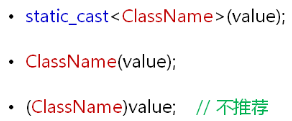C++解析(20):智能指针与类型转换函数
0.目录
1.智能指针
2.转换构造函数
3.类型转换函数
4.小结
1.智能指针
内存泄漏(臭名昭著的Bug):
- 动态申请堆空间,用完后不归还
- C++语言中没有垃圾回收机制
- 指针无法控制所指堆空间的生命周期
我们需要什么:
- 需要一个特殊的指针
- 指针生命周期结束时主动释放堆空间
- 一片堆空间最多只能由一个指针标识
- 杜绝指针运算和指针比较
解决方案:
- 重载指针特征操作符( -> 和 * )
- 只能通过类的成员函数重载
- 重载函数不能使用参数
- 只能定义一个重载函数
示例——实现智能指针:
#include <iostream>
#include <string>
using namespace std;
class Test
{
int i;
public:
Test(int i)
{
cout << "Test(int i)" << endl;
this->i = i;
}
int value()
{
return i;
}
~Test()
{
cout << "~Test()" << endl;
}
};
class Pointer
{
Test* mp;
public:
Pointer(Test* p = NULL)
{
mp = p;
}
Pointer(const Pointer& obj)
{
mp = obj.mp;
const_cast<Pointer&>(obj).mp = NULL;
}
Pointer& operator = (const Pointer& obj)
{
if( this != &obj )
{
delete mp;
mp = obj.mp;
const_cast<Pointer&>(obj).mp = NULL;
}
return *this;
}
Test* operator -> ()
{
return mp;
}
Test& operator * ()
{
return *mp;
}
bool isNull()
{
return (mp == NULL);
}
~Pointer()
{
delete mp;
}
};
int main()
{
Pointer p1 = new Test(3);
cout << p1->value() << endl;
Pointer p2 = p1;
cout << p1.isNull() << endl;
cout << p2->value() << endl;
return 0;
}
运行结果为:
[root@bogon Desktop]# g++ test.cpp
[root@bogon Desktop]# ./a.out
Test(int i)
3
1
3
~Test()
智能指针的使用军规——只能用来指向堆空间中的对象或者变量
2.转换构造函数
再论类型转换:
C语言标准数据类型之间会进行隐式的类型安全转换
C语言转换规则如下:

(C语言编译器支持从小类型(占用内存少)转换到大类型(占用内存多)的隐式类型转换,因为这样的转换是安全的,不会发生数据截断或者数据丢失。)
示例——隐式类型转换的bug:
#include <iostream>
#include <string>
using namespace std;
int main()
{
short s = 'a';
unsigned int ui = 1000;
int i = -2000;
double d = i;
cout << "d = " << d << endl;
cout << "ui = " << ui << endl;
cout << "ui + i = " << ui + i << endl;
if( (ui + i) > 0 )
{
cout << "Positive" << endl;
}
else
{
cout << "Negative" << endl;
}
cout << "sizeof(s + 'b') = " << sizeof(s + 'b') << endl;
return 0;
}
运行结果为:
[root@bogon Desktop]# g++ test.cpp
[root@bogon Desktop]# ./a.out
d = -2000
ui = 1000
ui + i = 4294966296
Positive
sizeof(s + 'b') = 4
(在大多数编译器看来,int类型,也就是4个字节的整型数的运算是最高效的。而在sizeof(s + 'b')中,是做加法运算,左操作数和右操作数都可以安全的转换为int,那么可以采用更高效的方式来进行运算。于是就出现bug了!)
问题:
普通类型与类类型之间能否进行类型转换?
类类型之间能否进行类型转换?
再论构造函数:
- 构造函数可以定义不同类型的参数
- 参数满足下列条件时称为转换构造函数
- 有且仅有一个参数
- 参数是基本类型
- 参数是其它类类型
旧式的C方式强制类型转换:

编译器会尽力尝试让源码通过编译(普通类型->类类型):

示例——编译器自作聪明的行为:
#include <iostream>
#include <string>
using namespace std;
class Test
{
int mValue;
public:
Test() { mValue = 0; }
Test(int i) { mValue = i; }
Test operator + (const Test& p)
{
Test ret(mValue + p.mValue);
return ret;
}
int value() { return mValue; }
};
int main()
{
Test t;
t = 5; // t = Test(5);
Test r;
r = t + 10; // r = t + Test(10);
cout << r.value() << endl;
return 0;
}
运行结果为:
[root@bogon Desktop]# g++ test.cpp
[root@bogon Desktop]# ./a.out
15
编译器尽力尝试的结果是隐式类型转换。
隐式类型转换:
- 会让程序以意想不到的方式进行工作
- 是工程中bug的重要来源
工程中通过explicit关键字杜绝编译器的转换尝试
转换构造函数被explicit修饰时只能进行显示转换
转换方式:

示例——杜绝编译器的转换尝试:
#include <iostream>
#include <string>
using namespace std;
class Test
{
int mValue;
public:
Test() { mValue = 0; }
explicit Test(int i) { mValue = i; }
Test operator + (const Test& p)
{
Test ret(mValue + p.mValue);
return ret;
}
int value() { return mValue; }
};
int main()
{
Test t;
t = static_cast<Test>(5); // t = Test(5);
Test r;
r = t + static_cast<Test>(10); // r = t + Test(10);
cout << r.value() << endl;
return 0;
}
运行结果为:
[root@bogon Desktop]# g++ test.cpp
[root@bogon Desktop]# ./a.out
15
3.类型转换函数
问题:
类类型是否能够类型转换到普通类型?
类型转换函数:
- C++类中可以定义类型转换函数
- 类型转换函数用于将类对象转换为其它类型
- 语法规则:

示例——只有想不到,没有做不到:
#include <iostream>
using namespace std;
class Test
{
int mValue;
public:
Test(int i = 0) { mValue = i; }
operator int() { return mValue; }
};
int main()
{
Test t(100);
int i = t; // ==> t.operator int()
cout << "i = " << i << endl;
return 0;
}
运行结果为:
[root@bogon Desktop]# g++ test.cpp
[root@bogon Desktop]# ./a.out
i = 100
类型转换函数:
- 与转换构造函数具有同等的地位
- 使得编译器有能力将对象转化为其它类型
- 编译器能够隐式的使用类型转换函数
编译器会尽力尝试让源码通过编译:

类型转换函数 vs 转换构造函数:
- 无法抑制隐式的类型转换函数调用
- 类型转换函数可能与转换构造函数冲突
- 工程中以Type toType()的公有成员代替类型转换函数
示例——能通过编译的类型转换函数:
#include <iostream>
#include <string>
using namespace std;
class Test;
class Value
{
public:
Value() {}
};
class Test
{
int mValue;
public:
Test(int i = 0) { mValue = i; }
int value() { return mValue; }
operator Value()
{
Value ret;
cout << "operator Value()" << endl;
return ret;
}
};
int main()
{
Test t(100);
Value v = t; // ==> t.operator Value()
return 0;
}
示例——能通过编译的转换构造函数:
#include <iostream>
#include <string>
using namespace std;
class Test;
class Value
{
public:
Value() {}
Value(Test& t) {}
};
class Test
{
int mValue;
public:
Test(int i = 0) { mValue = i; }
int value() { return mValue; }
};
int main()
{
Test t(100);
Value v = t; // ==> Value(t)
return 0;
}
示例——冲突的类型转换函数与转换构造函数:
#include <iostream>
#include <string>
using namespace std;
class Test;
class Value
{
public:
Value() {}
Value(Test& t) {}
};
class Test
{
int mValue;
public:
Test(int i = 0) { mValue = i; }
int value() { return mValue; }
operator Value()
{
Value ret;
cout << "operator Value()" << endl;
return ret;
}
};
int main()
{
Test t(100);
Value v = t;
return 0;
}
报错信息为:
[root@bogon Desktop]# g++ test.cpp
test.cpp: In function ‘int main()’:
test.cpp:32: error: conversion from ‘Test’ to ‘Value’ is ambiguous
test.cpp:21: note: candidates are: Test::operator Value()
test.cpp:12: note: Value::Value(Test&)
示例——使用explicit关键字避免冲突:
#include <iostream>
#include <string>
using namespace std;
class Test;
class Value
{
public:
Value() {}
explicit Value(Test& t) {}
};
class Test
{
int mValue;
public:
Test(int i = 0) { mValue = i; }
int value() { return mValue; }
operator Value()
{
Value ret;
cout << "operator Value()" << endl;
return ret;
}
};
int main()
{
Test t(100);
Value v = t;
return 0;
}
4.小结
- 指针特征操作符( -> 和 * )可以被重载
- 重载指针特征符能够使用对象代替指针
- 智能指针只能用于指向堆空间中的内存
- 智能指针的意义在于最大程度的避免内存问题
- 转换构造函数只有一个参数
- 转换构造函数的参数类型是其它类型
- 转换构造函数在类型转换时被调用
- 隐式类型转换是I程中bug的重要来源
- explicit关键字用于杜绝隐式类型转换
- C++类中可以定义类型转换函数
- 类型转换函数用于将类对象转换为其它类型
- 类型转换函数与转换构造函数具有同等的地位
- 工程中以Type toType()的公有成员代替类型转换函数



【推荐】还在用 ECharts 开发大屏?试试这款永久免费的开源 BI 工具!
【推荐】国内首个AI IDE,深度理解中文开发场景,立即下载体验Trae
【推荐】编程新体验,更懂你的AI,立即体验豆包MarsCode编程助手
【推荐】轻量又高性能的 SSH 工具 IShell:AI 加持,快人一步
· .NET 原生驾驭 AI 新基建实战系列:向量数据库的应用与畅想
· 从问题排查到源码分析:ActiveMQ消费端频繁日志刷屏的秘密
· 一次Java后端服务间歇性响应慢的问题排查记录
· dotnet 源代码生成器分析器入门
· ASP.NET Core 模型验证消息的本地化新姿势
· 开发的设计和重构,为开发效率服务
· 从零开始开发一个 MCP Server!
· .NET 原生驾驭 AI 新基建实战系列(一):向量数据库的应用与畅想
· Ai满嘴顺口溜,想考研?浪费我几个小时
· ThreeJs-16智慧城市项目(重磅以及未来发展ai)